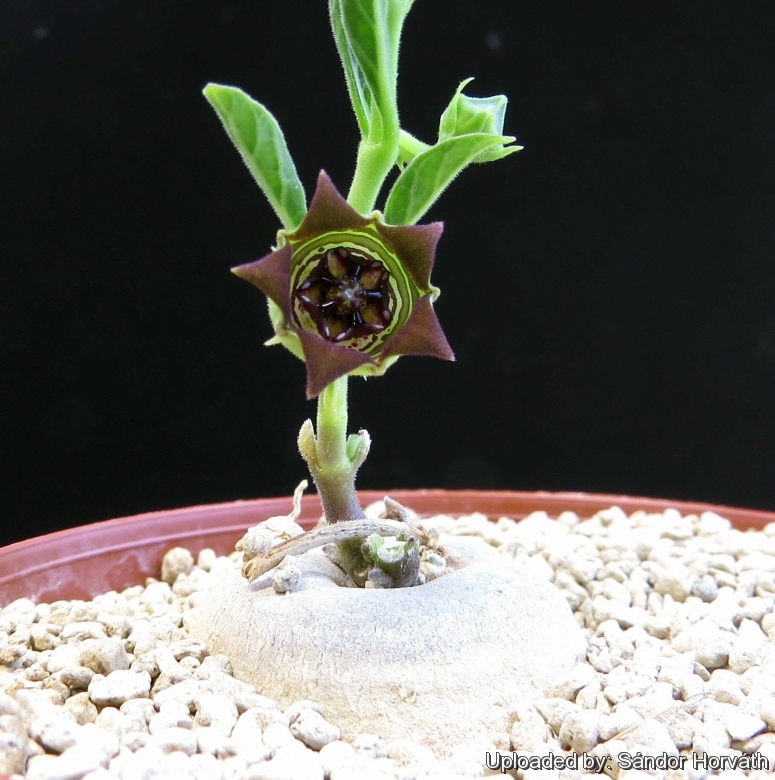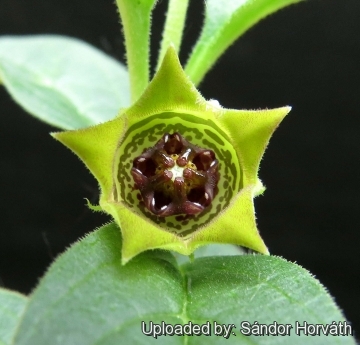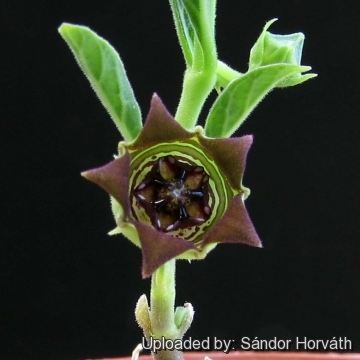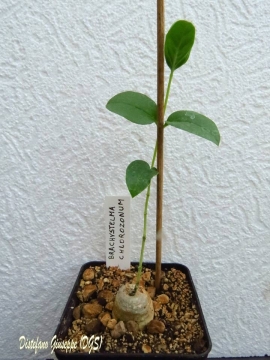




Your support is critical to our success.
- Encyclopedia of SUCCULENTS
- Encyclopedia Index
- Families
- Genera
- Species
- Asclepiadaceae
- Brachystelma
- Caudiciforms
Since 4 Aug 2013

Origin and Habitat: Republic of south Africa, KwaZulu-Natal, Mpumalanga. Range Barberton, northern KwaZulu-Natal and Ozwatini. Unconfirmed records from near Tzaneen. Known from a few, scattered and isolated records across a large range (Extent of occurrence 50 000 km²) but it is thought to be very rare within its range.
Altitude range: From sea level in northern Zululand to above 1000 metres.
Habitat and Ecology: Brachystelma chlorozonumSN|32299]]SN|32299]] occurs in a wide range of Bushveld habitats, mainly in the grassland on the Makatini Flatsand, in Songimvelo Game Reserve and on mountain slopes. This species previously considered to be Rare in South Africa is threatened by habitat degradation, severe overgrazing, rural development and sugarcane cultivation, but new subpopulations have been found along the escarpment in Swaziland.
Synonyms:
- Brachystelma chlorozonum E.A.Bruce
Description: Brachystelma chlorozonumSN|32299]]SN|32299]] is a perennial herb with little-branched, white-hairy stems arising from a depressed tuber (caudex). Leaves ovate elliptic, hairy on both surfaces, short-stalked. The bell-shaped flowers are pendulous, solitary, yellowish-green, hairy, with green, maroon or almost black ring-markings.
Derivation of specific name: The specific name 'chlorozonum' comes from the Greek, 'chloros' (green) and Latin, 'zona' (a band), referring to the characteristic banded colouring of the flowers.
Tuber (caudex): Depressed-globose, up to about 70 mm across.
Stem: Mostly solitary, single or little-branched, partially reclined to erect, 10-20 cm, densely pubescent, somewhat bristly.
Leaves: Stalked short, arranged in an alternate or opposite position, lamina ovate-elliptic, 20-45 mm long, 15-25 mm wide, densely pubescent to long hairy on both surfaces.
Inflorescence: 1-flowered, almost sessile to shortly pedunculate, lateral at nodes. Pedicels 5 mm long more or less recurved. Corolla 10-30 mm in diameter, divided to about the middle, outside yellowish-green, hairy, tube campanulate to shallowly bowl-shaped, 3-6 deep, 7-13 mm in diameter, with 1 to 4, or even 5, greenish to very dark purple-brown concentric ring-markings within on yellowish background, minutely green-spotted and glabrous around corona, finely hairy above ring-markings. Corolla lobes 3.5-8 mm, broadly triangular, often strongly reflexed, greenish-yellow, with whitish or purplish hairs. Corona sessile, red-brown, 1.5 deep, 4 mm in diameter, bowl-shaped equalling staminal column, forming 5 deep pockets with outer margin emarginate or V-shaped, mainly reddish-brown, sometimes whitish pubescent on rim, confluent on lateral margins with base of inner lobes. Outer corona-lobes pouch-like, ovate to almost quadrangular, apically obtuse or somewhat indented, margin sometimes pubescent. Inner lobes linear-lingulate, placed against the anthers. Pollinia sub-quadrangular, 0.4 x 0.25 mm.
Blooming season:Flowering is from late October to early March, often influenced by rain.
Fruits (follicles): One or two follicles per flower, thickly fusiform, thick-walled, c. 40 mm long, 12 mm in diameter.
Seeds: Broadly ovate, broadly winged.
Notes: Brachystelma chlorozonum, togheter with Brachystelma barberae, Brachystelma bracteolatum, Brachystelma buchananiiSN|32303]]SN|32303]], Brachystelma floribundum, Brachystelma megasepalum and Brachystelma oianthum, is component part of a group of species with crawling to decumbent-ascending stems, wide, almost sessile, hairy leaves, robust ovoid to D-shaped pollinia and thick-walled follicles.
Bibliography: Major references and further lectures
1) David Hardy, Anita Fabian, Gerrit Germishuizen “Succulents of the Transvaal” Southern Book Publishers, 1992
2) Gerrit Germishuizen “Transvaal Wild Flowers” Macmillan South Africa (Publishers), 1982
3) Focke Albers, Ulrich Meve “Illustrated Handbook of Succulent Plants: Asclepiadaceae: Asclepiadaceae”, Volume 4 Springer Science & Business Media, 2002
4) J.P. Roux “Flora of South Africa”, 2003
5) Dyer, R.A. 1972. “Brachystelma chlorozonum”. Flowering Plants of Africa 42(1-2):t.1659.
6) Dyer, R.A. 1980. “Brachystelma, Ceropegia and Riocreuxia”. In: O.A. Leistner (ed). Flora of Southern Africa 27 Part 4:1-88. Botanical Research Institute, Pretoria.
7) Dyer, R.A. 1983. “Ceropegia, Brachystelma and Riocreuxia in southern Africa”. A.A. Balkema, Rotterdam, Netherlands.
8) Germishuizen, G., Meyer, N.L., Steenkamp, Y. and Keith, M. (eds). 2006. “A checklist of South African plants”. Southern African Botanical Diversity Network Report 41 SABONET, Pretoria.
9) Hilton-Taylor, C. 1996. “Red data list of southern African plants”. Strelitzia 4. South African National Botanical Institute, Pretoria.
10) Peckover, R.G. 1997. “Brachystelma chlorozonum E.A. Bruce”. Kakteen und andere Sukkulenten 48(5):102-103.
11) Raimondo, D., von Staden, L., Foden, W., Victor, J.E., Helme, N.A., Turner, R.C., Kamundi, D.A. and Manyama, P.A. 2009. “Red List of South African Plants”. Strelitzia 25. South African National Biodiversity Institute, Pretoria.
12) Burrows, J.E., Lötter, M. & von Staden, L. 2005. “Brachystelma chlorozonum E.A.Bruce.” National Assessment: Red List of South African Plants version 2015.1. Accessed on 2016/01/11
13) M Graham, G de Winnaar, C Cowden, D Styles, J Harvey “Basic Assessment for the Candover-Mbazwana, Mbazwana-Gezisa Eskom Distribution 132kV powerlines and Mbazwana and Gezisa 132/22kV Substations, northern KwaZulu-Natal” Biodiversity
Report. May 2012
14) Janice Golding,“Southern African Plant Red Data Lists”, Southern African Botanical Diversity Network Report No. 14, 2002.

Brachystelma chlorozonum Photo by: Sándor Horváth

Brachystelma chlorozonum Photo by: Sándor Horváth

Brachystelma chlorozonum Photo by: Sándor Horváth

Brachystelma chlorozonum Photo by: Giuseppe Distefano
Cultivation and Propagation: In cultivation the plants are usually grown in semi shade, with the tubers wholly or (preferably) partially exposed to prevent scorching and rotting of the roots. This plant can take a good deal of water during active growth and should be watered only when not dormant. Keep dryish in winter. It should be overwintered in the greenhouse at temperatures over 12°C (avoid letting temperatures drop lower than 5° C). Use a very draining but rich soil. An error in cultivation may produce unsightly holes in the tuber.
Reproduction: This species can be reproduced by seeds. Sow seeds in summer in a well drained medium.
| Your Actions | |
|---|---|
| Back to Brachystelma index | |
| Back to Asclepiadaceae index | |
 |
Back to Succulents Encyclopedia index |
Privacy stantement - Terms and conditions - How to cite - About us - Feedback - Donate



